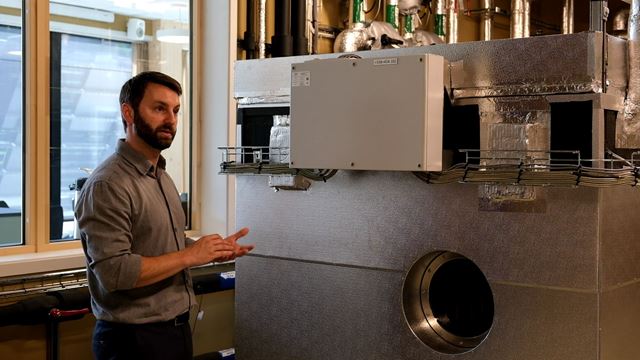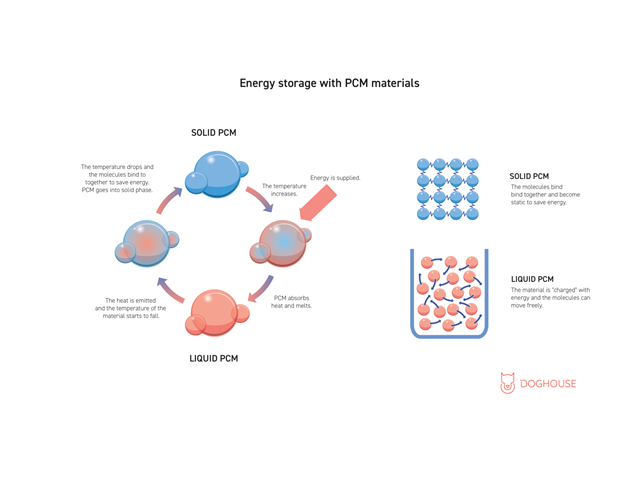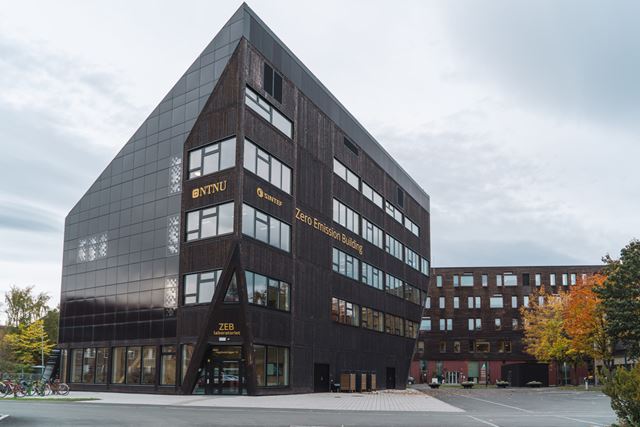From the outside it looks like a silver-coloured container with a small round window cut into the side and several pipes leading in and out. Heat is first drawn into the system and then, after a while, is released again.
This ‘container’ makes it possible to store heat energy generated on sunny and windy days and release it again when the weather gets colder. The technology driving the system is based on what are called ‘phase change materials’ (PCMs) in combination with heat pumps.
In fact, the source of the energy can be anything from electricity generated by solar panels, waste heat from a factory building or surplus energy from a wind turbine. Here, at the ZEB (Zero Emission Building) laboratory operated by SINTEF and NTNU, the energy for storage is sourced from the solar panels that cover most of the building’s roof and south-facing facade.
Water is the world’s most common phase change material
But what is a phase change material? Alexis Sevault is a Research Manager at SINTEF Energy Research and is more than happy to explain.
In fact, water is a phase change material in its simplest and most familiar form. It can turn into ice crystals when the temperature falls below zero degrees Celsius, become a liquid as the temperature rises, and change into steam as it approaches 100 degrees. Water also has the ability to behave differently in its different phases and, most importantly, can store heat in its liquid form.

Alexis Sevault explaining the device that acts as a biological heat storage system. Photo courtesy of Karoline Ravndal Lorentzen
Scientists give the name phase changing materials, or PCMs, to materials that behave differently in their different phases and that can also store heat.
There are many PCMs that can store heat when in their liquid form. What makes these materials interesting and, not least, practical in this context is that their melting points are not zero degrees.
Melting point: 37 degrees Celsius
This property enables PCMs to be utilised as so-called ‘heat banks’. In other words, as batteries. The big silver-coloured container in the ZEB laboratory contains a PCM that melts at body temperature.
“The device contains three tonnes of a liquid biowax based on a vegetable oil that cannot be used as food”, says Sevault. “In the same way that water turns into ice, the wax becomes a solid, crystalline material when it becomes sufficiently cold. ‘Cold’ for this particular wax means below 37 degrees”, he says, and goes on to add:
“But there are other types of biowax that have different melting points, all offering opportunities for many similar applications”.
Facts about the ‘bio-battery’:
The entire heat storage device is made up of 90 percent PCM. It also contains a heat exchanger that enables us to extract the heat that is stored inside. This is achieved with the help of 24 so-called cushion plates that release heat to the process water which serves as an energy carrier that removes the heat from the storage system. Together, the PCM and the plates enable the heat bank to be both compact and efficient.
Smart molecules
If we examine the biowax in detail, we find that it is made up of molecules that behave very economically in terms of heat.
In order to save energy, the molecules arrange themselves very closely together when the biowax is in its solid phase. They cluster close to each other and keep relatively still, not unlike a flock of cold penguins on an ice floe.
As the material melts, the bonds holding the molecules together are loosened and they begin to move about with what we call kinetic energy. As more heat is supplied from their surroundings, the molecules become more excited. Finally, they are released from their bonds and can vibrate freely and independently. When this happens, the biowax has changed its phase and has become a liquid.
And the opposite is true. When the wax changes from a liquid to a solid, the molecules release a large share of their kinetic energy to their surroundings. They stop vibrating and begin to cluster together again in order to save energy. The wax then reverts to a solid.

This is what happens to the molecules of a PCM material that is used in a heat storage system. Diagram courtesy of Doghouse/Knut Gangåssæther
Bio-based and maintenance-free
This is the phenomenon that researchers are exploiting in the silver container. The energy collected by the building’s external solar panels is conducted via a heat pump into the big ‘battery’, and it is here that the biowax molecules are free to dance to their hearts’ content – full of their liquid energy.
When the time comes to extract the energy, liquid water is assigned the job of the ‘practical energy carrier’. First of all, cold water is sent through the heat storage system. After a short while, the now heated water is released from the device and directed to the radiators and the ventilation system, supplying heated air to the building.
An effective, functional system
This technology has now been in use as part of the ZEB Laboratory’s heating system for more than a year.

The ZEB laboratory operated by NTNU and SINTEF in Trondheim. Energy from the laboratory’s solar panels is stored as heat in a so-called bio-battery. This energy is then used to heat the building when the weather is cold and the sun isn’t shining. Photo courtesy of SINTEF
“The PCM-based heat storage system is delivering exactly the performance we expected”, says Alexis Sevault. “We’re utilising as much as possible of the building’s self-produced solar energy. We’re also finding that the system is very well suited to so-called ‘peak shaving’”, he says.
“By charging the bio-battery prior to the coldest parts of the day, we prevent the building from consuming valuable grid electricity at times when the rest of Trondheim is also experiencing major demand”, says Sevault. “This offers us a level of flexibility that can also be used to exploit fluctuations in the spot price. We can charge our battery when we have access to energy from the sun, wind and waste heat, and extract output when the electricity price is high”, he explains.
Moreover, the first year of operation has provided large volumes of data that researchers are now going to use to optimise both the design and operation of the system so that as much output as possible can be extracted.
Best suited to industrial applications
The system is thus much less sophisticated than a traditional battery – but it isn’t suitable for all buildings. As a new technology, investment costs remain high. The drawback is that such a system won’t work for everyone. At least not at present.
“This system will be ideal for industrial and office buildings, and in neighbourhoods where the heat can be distributed”, says Sevault. “The best part about it is that the technology is virtually maintenance-free. It will last for at least 25 years”, he says.
The researchers are also working to develop smart control systems with the aim of optimising output. These will enable the system as a whole to respond to, and be regulated in accordance with, the needs of its surroundings. This means in practice that the way in which the system is exploited may be guided by factors such as weather forecasts and fluctuations in the electricity price. This research is being carried out by SINTEF in collaboration with NTNU. It is being funded by ZEN (Zero-Emission Neighbourhoods) which is a Centre for Environmentally-Friendly Energy Research. Together with many other research divisions within NTNU and SINTEF, the researchers have established a Gemini Centre called Thermal Energy Storage.
A SINTEF spin-off
The researchers who have developed the ‘bio-battery’, or PCM heat storage system as the experts call it, are now in the process of establishing a company with the aim of commercialising the technology. This is happening in collaboration with SINTEF’s in-house start-up support division, SINTEF TTO.
“We envisage that after several months of testing at the ZEB laboratory, we can safely start the concept on its journey towards commercialisation”, says Sevault. “We’ve also established contact with many end users who are interested in having a pilot system installed in 2023 or 2024. Many of these are industrial companies who have the resources to scale up the concept”, he says.
Facts about the ZEB Laboratory and PCM heat storage systems:
The ZEB (Zero-Emission Building) Laboratory is an office complex jointly owned by NTNU and SINTEF. It is funded by NTNU, SINTEF, the Research Council of Norway and the green energy funding agency ENOVA.
The laboratory houses the following energy systems:
- A solar energy facility (180 kWp)
- A low-heat heating system based on propane and an air-to-water heat pump
The PCM heat storage system:
- Heat storage capacity: 200 kWh, which corresponds to sufficient energy to heat the building for three to four days during the coldest part of the year.
- It contains three tonnes of a biowax-based PCM with a melting point of 37 degrees Celsius.

